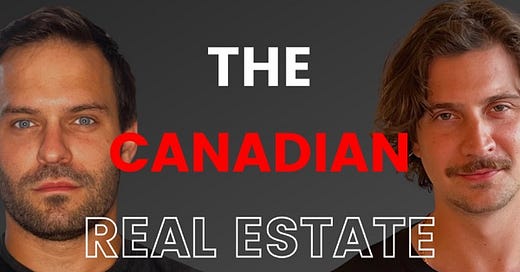Carney vs. Poilievre on Fixing the Housing Crisis
Listen to the full episode below:
Canada’s 2025 Housing Election: A Real Estate Policy Showdown
With affordability at historic lows, supply lagging far behind demand, and immigration fueling rapid population growth, housing is set to dominate Canada’s 2025 federal election. The two frontrunners — Mark Carney (Liberal) and Pierre Poilievre (Conservative) — offer starkly different visions for solving the housing crisis.
Both agree: Canada needs to double housing construction. But their approaches differ on who should build, how to incentivize it, and what role government should play.
Source: Movesmartly.com
Mark Carney’s Liberal Platform: A Modern Housing Marshall Plan
Carney’s platform is arguably the most ambitious since WWII. The core goal is to double the pace of homebuilding, from ~230,000 per year to 500,000 annually over the next decade — a target aligned with CMHC’s projection of what’s needed to restore affordability.
His strategy includes:
A new public agency, Build Canada Homes, to lead development, especially on federal lands.
$25 billion in financing and loan guarantees to boost modular and prefabricated housing.
GST eliminated on new homes under $1M — but only for first-time buyers.
Development charge reductions, with matching infrastructure support for municipalities.
Revival of the MURB program — offering tax incentives to investors and developers who build new rental units, mirroring the original 1970s-era Multiple Unit Residential Building incentive.
Doubling of non-profit and co-op housing stock, including supports for Indigenous-led projects.
Investments in skilled trades and construction innovation, including low-carbon materials.
Carney’s platform takes a “Team Canada” approach, aiming to coordinate federal, provincial, and municipal actors, while emphasizing long-term value, sustainability, and social equity. It blends market support with public investment, hoping to catalyze private capital without leaving affordability to the market alone.
Pierre Poilievre’s Conservative Platform: Build or Lose Funding
Poilievre’s plan, dubbed “Building Homes, Not Bureaucracy,” frames the housing crisis as a failure of local governments, overregulation, and “gatekeepers” who block development.
His key proposals include:
Mandating a 15% annual increase in housing starts for major cities — with funding clawbacks if targets aren’t met.
Rewarding over-performing cities with federal “building bonuses.”
Eliminating the GST on all new homes up to $1.3M, for any buyer — not just first-timers.
Unlocking 15% of federal land and buildings for housing within 18 months.
Firing or docking CMHC officials if permitting delays persist.
Tying transit funding to housing density — no homes, no transit dollars.
Poilievre is not proposing new federal housing programs or subsidies. His strategy relies on removing barriers and forcing municipalities to allow more homes to be built faster. His plan is highly pro-market, placing the responsibility for housing delivery on the private sector and aiming to “unleash builders.”
Keep reading with a 7-day free trial
Subscribe to Daniel’s Substack to keep reading this post and get 7 days of free access to the full post archives.





